Uncover the enigmatic role of dragons in the Bible, symbols of chaos and evil, and see what deeper truths they might reveal.
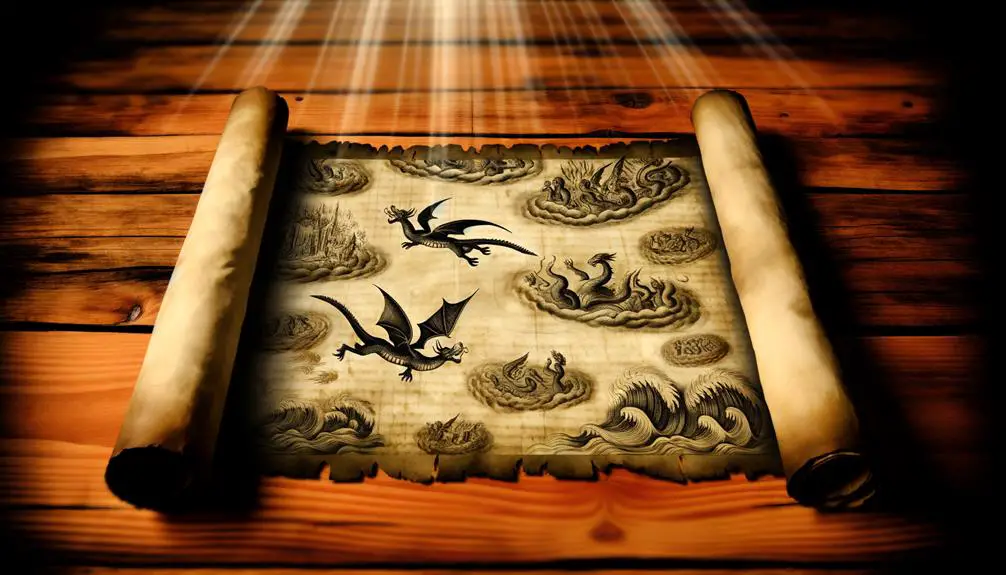
Dragons in the Bible Verses
In the Bible, you'll encounter dragons primarily as symbolic entities representing chaos, evil, and moral decay. The Hebrew term 'tannin' and the Greek 'drakon' uncover these creatures' malevolent attributes. Especially in the Old Scripture and apocalyptic writings like Revelation, dragons symbolize spiritual and moral challenges. They're often portrayed in divine confrontations, illustrating the cosmic struggles between good and evil. These mythical beings extend beyond mere mythical creatures; they encompass deeper theological debates about divine justice and human sinfulness. Exploring these passages further could offer profound insights into the spiritual and moral dimensions they embody.
Key Takeaways
- Dragons symbolize chaos and moral conflict in biblical texts, as seen in Old Testament and Revelation.
- The Hebrew word 'tannin' and Greek 'drakon' are often translated to 'dragon', representing powerful, malevolent forces.
- In the Book of Revelation, the dragon represents Satan, embodying ultimate evil and opposition to divine forces.
- Dragons are used metaphorically to depict profound spiritual battles and divine judgment across biblical narratives.
- Biblical references to dragons include Isaiah, Psalms, Job, and prominently in the apocalyptic imagery of Revelation.
Historical Context of Dragons

Throughout history, dragons have often symbolized chaos and evil, profoundly influencing various cultures' mythology and religious texts. You'll find that these creatures' mythological origins are steeped in the collective fears and philosophical ponderings of ancient civilizations. In exploring these origins, it's clear that dragons were not merely fantastical beasts but embodied the unknown and uncontrollable forces of nature.
Different cultures perceived dragons through unique lenses. In Eastern traditions, dragons could signify wisdom and strength, often associated with water and seasonal rains. Conversely, in Western narratives, they more typically symbolized destruction and were adversaries to be conquered by heroes. This dichotomy in cultural perceptions underscores a broader theme: dragons served as a mirror to society's values and the challenges it faced.
The evolution of dragon myths provides insight into how these creatures transcended specific cultural boundaries to become universal symbols in human storytelling. Their adaptability in various cultural contexts highlights their role not just as mythical creatures but as fundamental archetypes in human psychological and sociological frameworks. Therefore, understanding the historical context of dragons enriches your comprehension of their persistent presence in modern media and literature, reflecting enduring human concerns across ages and civilizations.
Dragon References in the Old Testament
Building on the historical significance of dragons, the Old Scripture also incorporates these creatures into its narratives, reflecting the ancient Hebrews' views on chaos and moral order. As you explore further into the texts, you'll find that dragon references are not literal but metaphorical, used to symbolize profound chaos and moral degradation.
The dragon etymology in Hebrew, often translated as 'tannin,' appears in various books, portraying these creatures as powerful and sometimes malevolent. This term and its cultural depictions bridge the gap between ancient mythologies and biblical narratives, highlighting the shared motifs across civilizations.
Here's a brief overview of some notable Old Testament references to dragons:
Verse |
Description |
Significance |
|---|---|---|
Isaiah 27:1 |
Leviathan, the twisting serpent |
Symbol of chaos subdued by God |
Psalm 74:13 |
Sea monsters divided by God |
Emblem of divine victory over chaos |
Job 30:29 |
Companion of jackals and ostriches |
Illustration of desolation and isolation |
These passages aren't just ancient texts; they're part of a larger discourse on the role of mythical creatures in conveying moral lessons. Understanding these cultural depictions and the development of dragon etymology provides you with a richer appreciation of how deeply intertwined these myths are with the foundational texts of Western civilization.
Interpretations of Biblical Dragons
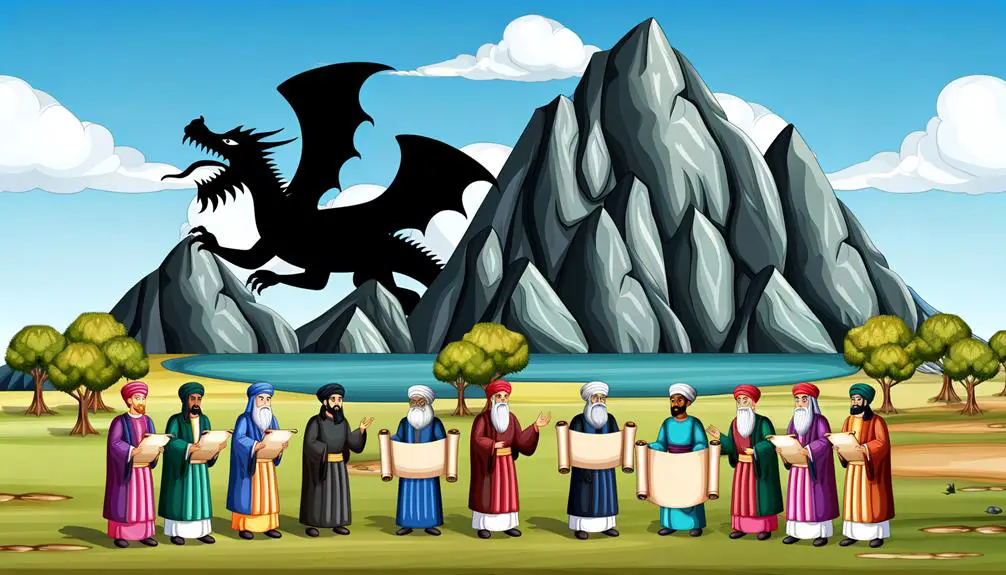
The interpretations of biblical dragons often reflect the text's deeper themes of moral struggle and divine supremacy. When you explore dragon etymology within biblical contexts, it's important to acknowledge that the term 'dragon' in ancient scripts typically translates from Hebrew and Greek words like 'tannin' and 'drakon.' These terms don't strictly align with the modern image of dragons as fire-breathing creatures of Western mythology but rather point to serpentine or monstrous beings that embody chaos and evil.
Your understanding of these creatures' roles in scripture hinges on recognizing their symbolic function rather than expecting mythical accuracy. The biblical authors didn't intend to describe real beasts but used the dragon as a metaphor to articulate moral and spiritual conflicts. This approach helps clarify why dragons appear in contexts of divine confrontation and judgment, serving as embodiments of the forces opposed to the divine order.
As you analyze these texts, it's important to take into account how interpretations have evolved. Earlier scholars might have taken dragon references at face value, promoting a literal belief in their existence. However, contemporary biblical scholarship advises that you view these references as allegorical, focusing on the underlying message about God's sovereignty over all forms of chaos and evil.
Symbolism of Dragons in Scripture
When examining the symbolism of dragons in scripture, it is important to acknowledge their role as metaphors for chaos and moral corruption. These dragon metaphors are not just ancient fantasy but carry deep mythological parallels that reflect universal themes found in many cultures. You can see how dragons often represent the forces that oppose divine order, making them potent symbols of disruption and sin.
Analyzing these mythological parallels further, dragons in the Bible are not merely creatures to be feared. They embody the struggle between good and evil, serving as a reminder of the spiritual warfare that believers are called to engage in. The table below highlights key aspects of dragon symbolism in scripture:
Aspect |
Description |
Example |
|---|---|---|
Chaos |
Dragons symbolize disorder and opposition to God |
Leviathan in Job |
Moral Corruption |
Their presence denotes decay of moral values |
Dragon in Revelation |
Mythological Parallel |
Links to similar creatures in other cultures |
Serpents in Greek myths |
Understanding these symbols helps you appreciate the biblical narrative's complexity and its relevance to both ancient and modern spirituality. Each reference to a dragon carries layers of meaning, enriched by cultural and theological insights.
Dragons in Apocalyptic Literature
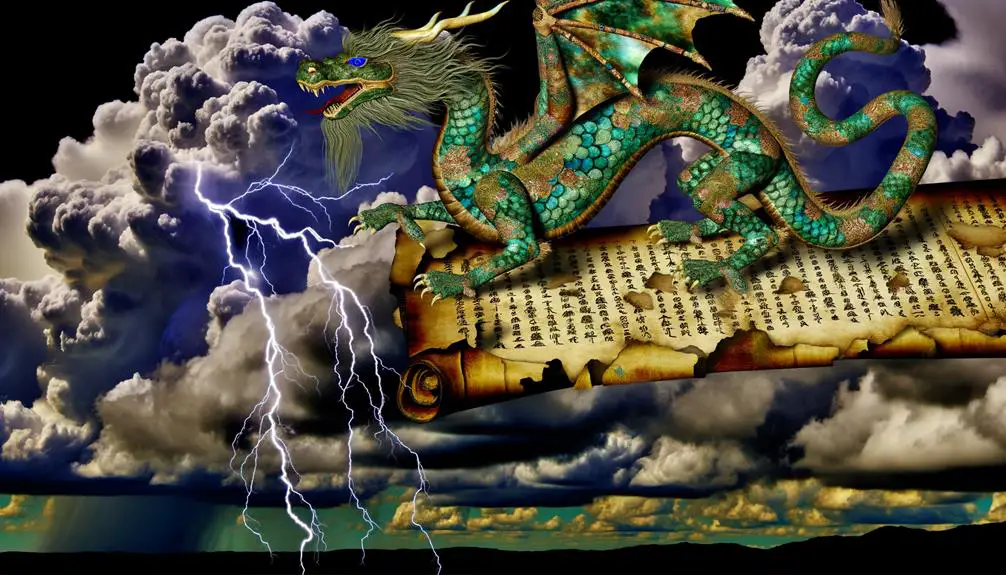
As you analyze the symbolism of dragons in biblical texts, it's essential to take into account their role in apocalyptic literature, particularly within the Book of Revelation. Here, dragons aren't merely mythical creatures but serve as pivotal symbols of chaos and evil, challenging the forces of good. Understanding these representations helps in interpreting the broader theological and eschatological themes present in these prophetic texts.
Symbolism of Biblical Dragons
Delving into biblical dragons, particularly in apocalyptic literature, reveals their role as potent symbols of chaos and evil. These creatures often serve as dragon metaphors, emphasizing the struggle between divine forces and malevolent entities. Their depiction is not merely about fear; it's a rich tapestry of cultural representations, reflecting and shaping the perceptions of evil within a community.
- Chaos: Dragons symbolize disorder, opposing the creation's harmony.
- Moral Conflict: They represent the eternal battle between good and evil.
- Judgment: Dragons are instruments in divine retribution scenarios.
- Transformation: They signify the potential for change, whether through destruction or renewal.
Understanding these elements allows you to grasp deeper theological and existential concepts woven into the narrative fabric of biblical texts.
Dragons: Revelation's Imagery
Building on our understanding of dragons as symbols, Revelation's apocalyptic literature further develops this imagery to explore themes of ultimate cosmic conflict. You'll see dragon metaphors embodying celestial conflict, often casting the dragon as a formidable opponent against divine entities. This imagery isn't just for dramatic effect; it's a critical narrative tool that intensifies the spiritual and moral battles depicted.
Emotion Evoked |
Description of Imagery |
|---|---|
Fear |
Dragon as a colossal, menacing beast |
Awe |
Dragon's vast power and presence |
Desperation |
Human struggle against dragon |
Hope |
Divine intervention in conflict |
Triumph |
Overcoming of dragon |
These elements aren't random; they're crafted to connect with you on a deep emotional level, reflecting the profound struggles within Revelation.
Interpreting Apocalyptic Dragons
When interpreting dragons in apocalyptic literature, it is imperative to recognize their role not just as mythic creatures but as profound symbols of chaos and moral confrontation. Dragon metaphors in these texts often serve multiple layers of meaning, emphasizing the complexity of apocalyptic representation. Here's what you should consider:
- Symbolic significance: Dragons often embody societal fears and ultimate evil.
- Contextual interpretation: Understand how dragons reflect the specific anxieties of the time.
- Literary function: Analyze how dragons advance the narrative or thematic elements of the apocalypse.
- Theological implications: Consider what dragons reveal about the nature of divine justice or moral order.
Comparative Mythology of Dragons
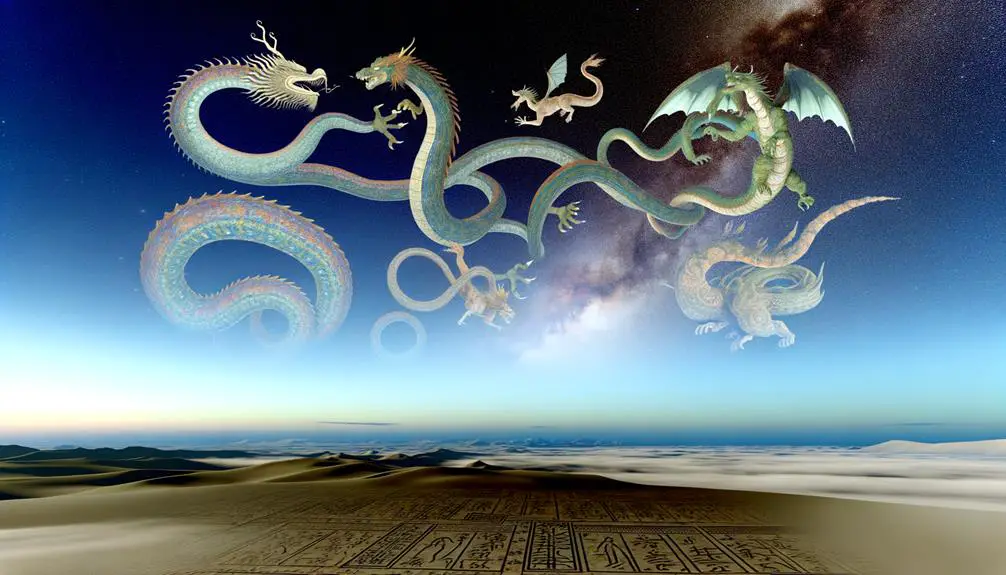
Across various cultures, dragons often symbolize primal forces, embodying concepts of power and mystery that resonate deeply with human psychology. The etymology of the word "dragon" traces back to the Greek *drakon*, meaning "to see clearly" or "watcher." This etymological root reflects the dragon's role in various mythologies as a guardian of sacred treasures or knowledge. This guardian role forms a mythological parallel across different cultures.
In Chinese mythology, dragons are seen as benevolent creatures symbolizing strength, good fortune, and the power of water elements. Contrastingly, in Western traditions, dragons are more frequently depicted as malevolent beings hoarding treasures and menacing heroes. Despite these differences, the underlying archetype of a powerful, serpentine creature taps into a universal cultural vein.
Analyzing these mythological parallels, you can perceive a pattern in how societies use dragons to represent the unknown and the formidable challenges humans must overcome. The dragon's dual aspect of being both guardian and destroyer adds layers to its symbolic significance, influencing its depiction in religious texts, including the Bible. Here, dragons often embody chaos and moral decay, yet they also challenge heroes to rise to greater spiritual heights.
Dragons in the Book of Revelation
In the Book of Revelation, the dragon emerges as a pivotal symbol of chaos and evil, challenging the forces of good and shaping the narrative's apocalyptic visions. This imagery is not merely for dramatic effect; it's deeply woven into the fabric of the text's theology and eschatology.
Here's how the dragon's depiction unfolds:
- Representation of Satan: The dragon is explicitly identified as Satan, the deceiver of the whole world. This identification links the dragon to a broader biblical narrative of fall and redemption.
- Conflict with the Archangel: The dragon engages in a celestial battle with Michael and his angels, underscoring the cosmic scale of the conflict depicted in Revelation.
- Pursuit of the Woman: The dragon's pursuit of the woman clothed with the sun, who gives birth to a male child, infuses the narrative with dramatic tension and highlights the threat the dragon poses to the divine plan.
- Control of the Beast: The dragon gives power to the beast, enhancing the beast symbolism. This alliance between the dragon and the beast marks a consolidation of evil forces, intensifying the apocalyptic struggle.
Through these elements, dragon metaphors in Revelation serve as a pivotal vehicle for conveying the themes of ultimate struggle between divine and demonic forces.
Theological Implications of Dragons
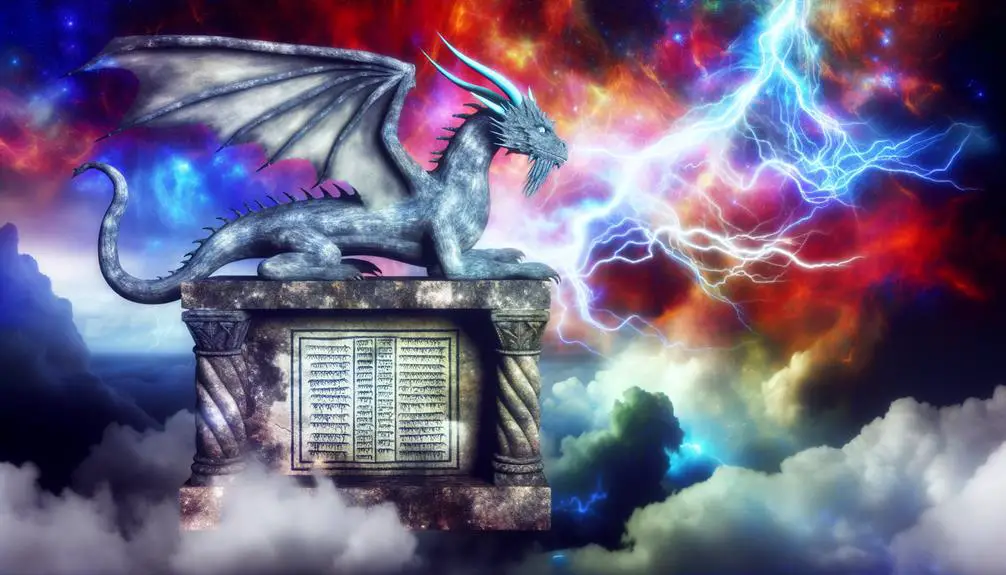
You'll find that the symbolism of dragons in biblical texts often reflects complex theological themes. These creatures' roles in eschatological narratives, such as those found in Revelation, serve as potent symbols of chaos and evil opposing divine order. Understanding these implications can provide deeper insights into the broader spiritual battles depicted throughout scripture.
Symbolism of Biblical Dragons
Dragons symbolize profound spiritual conflict and chaos within many Biblical narratives. Their appearances often reflect the struggle between divine forces and human sinfulness. Here's how you can understand their symbolic roles:
- Dragon Metaphors: They encapsulate the pervasive nature of evil, resisting God's order.
- Serpent Allegories: These creatures often intertwine with the imagery of serpents, suggesting deception and moral corruption.
- Representations of Sin: Dragons manifest the consequences of straying from divine paths.
- Symbols of Opposition: They stand against the protagonists, symbolizing the barriers to achieving spiritual purity.
Through these symbols, you're invited to explore further into understanding the complexities of good versus evil in the biblical context.
Dragons' Eschatological Role
Throughout biblical prophecy, dragons serve as a potent symbol for the ultimate battles between cosmic forces at the end of times. These dragon metaphors are not merely artistic flourishes but carry deep eschatological interpretations. In the apocalyptic texts, you'll find dragons depicted as embodiments of chaos and evil, often opposing divine authority and the eventual restoration of order.
Your understanding of these narratives is enhanced by recognizing that these dragons often symbolize the adversarial forces that humanity must overcome as part of the divine plan. The imagery of dragons in these contexts isn't just about fear; it's about the triumph of good over evil, a central theme in eschatological teachings. Dragons are not just creatures but pivotal elements within the theological framework predicting cosmic redemption.
Modern Translations and Dragons
In modern translations of the Bible, the depiction of dragons often reflects evolving linguistic and cultural understandings. You'll find that the term "dragon" in earlier translations like the King James Version might be rendered differently in newer versions due to changes in linguistic evolution and heightened focus on translation accuracy. This shift can alter your understanding of the text, as the connotations and imagery associated with "dragons" vary widely.
Here are key aspects that influence how dragons are presented in contemporary Bible translations:
- Linguistic Updates: As languages evolve, so do the meanings of words. "Dragon" in ancient texts often symbolized chaos and evil, a notion that might be expressed with different terms today to match modern language usage.
- Cultural Relevance: Modern translators often consider the cultural context of today's readers, choosing words or metaphors that resonate better with contemporary values and knowledge.
- Scholarly Research: Ongoing archaeological and philological research continually refines our understanding of ancient languages, which in turn affects how terms like "dragon" are translated.
- Theological Implications: Translators must weigh how their word choices impact the theological messages of the Scripture, ensuring that modern readers grasp the intended lesson without the distraction of archaic terms.
Understanding these factors helps you appreciate the complexity behind the translation process and the careful consideration needed to convey biblical texts accurately across ages and cultures.
Frequently Asked Questions
How Do Dragons Relate to Satan in Christian Theology?
In Christian theology, dragons often symbolize Satanic imagery. You'll find that theological interpretations link these creatures to Satan, portraying them as manifestations of evil and chaos in opposition to divine order.
Are Dragons Mentioned in the Dead Sea Scrolls?
Dragons aren't explicitly mentioned in the Dead Sea Scrolls. Your analysis should consider mythical interpretations and scroll authenticity, delving into how these ancient texts could metaphorically reference beings akin to dragons.
What Do Dragons Symbolize in Different Cultures?
In various cultures, dragons symbolize strength and wisdom, especially in Eastern mythology. During cultural festivals, they often represent protection and prosperity, reflecting deep-rooted beliefs in the mystical powers of these legendary creatures.
Can Dragons Be Linked to Any Historical Animals?
You might find that dragons can be linked to historical animals through mythical interpretations and paleontological connections, suggesting a blend of ancient myths and real creatures that inspired these legendary figures.
How Have Depictions of Biblical Dragons Evolved in Art?
In art, biblical dragons have morphed from Medieval iconography's menacing serpents to Renaissance interpretations, where they're more nuanced symbols. You'll see these shifts reflecting broader changes in cultural and theological perspectives.



Sign up